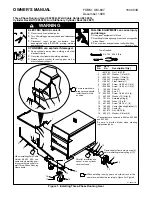
17
6 degrees and having the ceiling rise toward the rear of the room at a comparable rate will do wonders for the
room’s acoustics, if the wall design is solid and the angles are clearly intentional from the outset.
R
ATTLES
Rattles in the room are structural resonances (as opposed to standing waves, which are airborne resonances) that the
system may stimulate due to its broad frequency response and wide dynamic range. They are particularly prominent
for sounds in the lower frequencies, and can sound like distortion. Sources of rattles include: furniture, loose window
frames, walls, lighting fixtures, ventilation systems and even knickknacks on various shelves around the room. The
simplest way of identifying these rattles is by using a rattle test. This is an
extremely
slow low-frequency sweep from
20Hz to 500Hz, recorded at the reference level. Ten decibels of output level increase over the standard level may be
necessary in order to hear all the room rattles. Be careful with this test, as it is also a severe test of associated
amplifiers and speakers.
As the sweep makes its way up the frequency range, you will probably find a surprising number of rattles in your room.
All of these rattles will occur at one time or another during music or movies, but are usually perceived as background noise
or distortion in the system.
Once identified, eliminating the rattles is usually straightforward. As an example, small pieces of felt can be affixed
to the back of a painting (in the frame’s bottom corners) to prevent audible rattles against the wall. Likewise, strips
of felt can be wedged into a loose window rattling in its frame. Recessed lighting fixtures can be tightened up.
A piece of cloth can be placed under offending knickknacks.
Every home THX audio system should be subjected to the rattle test at least once – the difference in low-level
resolution and in freedom from pseudodistortion is sometimes large, while the effort involved is quite small.
B
ACKGROUND
N
OISE
The effect of background noise on system performance is dramatic, yet often overlooked. Most people might think of
it merely as a minor inconvenience, yet it has a profound effect on the way we perceive sound.
The presence of virtually constant background noise alters the way we perceive volume, since subjective loudness is
a relative measure. In a quiet room, even a 70dB SPL sound can seem fairly loud. In a noisy convention center, the
same volume would be barely audible. Since there is a practical upper limit to both the volume to which we should
subject ourselves and the volume a given system can reproduce, having a relatively noisy environment effectively
limits the perceived dynamic range of the program material. This, in turn, limits the dramatic effect that might have
been intended by the director or music artist.
Constant background noise also obscures, or masks, low-level signals that are frequently important in films. Many
scenes use subtle ambient noises to set the mood prior to an important event – without the full perception of the
whispered secret or the barely heard creaking of a door, the impact of the scene is diminished.
It has been demonstrated that even a relatively narrow-bandwidth noise can effectively reduce our hearing acuity
over a broad range of frequencies, far greater than the noise itself. When you add up all the various sources of noise
from electric motors, noisy heating/cooling systems and outdoor noises, plus noises that even audio and video com-
ponents can introduce such as noisy transformers, motors in laser players or projector fan noise, our ability to discern
the low-level information in the soundtrack is greatly compromised – and the director’s intention along with it.
F
INE
-T
UNING
Y
OUR
A
UDIO
S
YSTEM








































